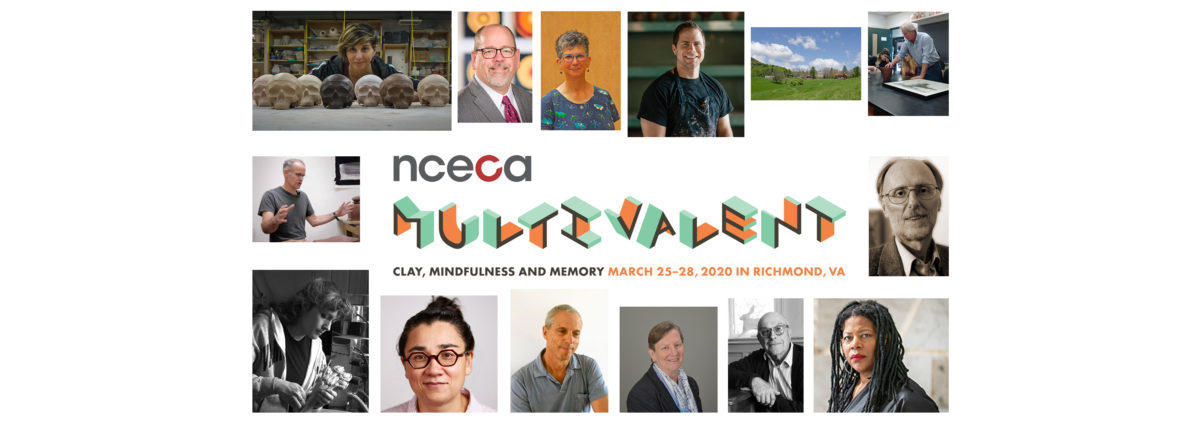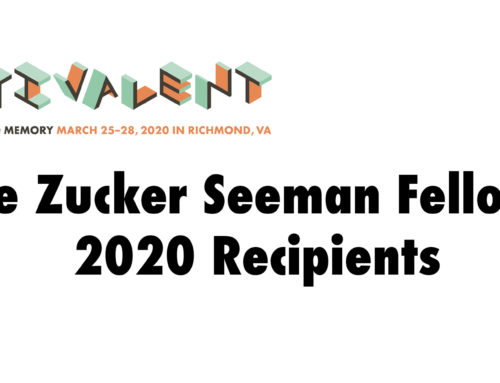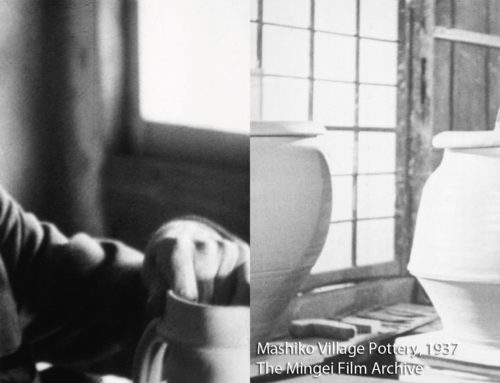You know them as wise advisors, educators, innovators, clay cultural leaders, and individuals who embody generous spirits. The NCECA Awards and Honors recognize leaders in the field of ceramics for their impact regionally, lifetime support of others, roles as educators, and outstanding projects. Each year we look for nominations for these recognitions, through an open call on the NCECA website (We’d love you to nominate someone for next year!). In addition to recognition at the conference, awardees and honorees receive lifetime memberships and conference passes to acknowledge the significant contributions each has made.
We hope you will join us when we recognize and celebrate this year’s Awardees and Honorees on Friday, March 27th, 5:15-6:45 pm, Grand Ballroom B, Greater Richmond Convention Center! For now, please read on to learn more about each award and to be introduced to each of our esteemed recipients.
Our special thanks to this year’s nomination committee for their thoughtful review of all nominees. 2020 Nominations Committee: Yinka Orafidiya, Pete Pinnell (co-chair), Ashlyn Pope, Judith Schwartz, Zach Tate, and Rhonda Willers (co-chair)
Regional Awards for Excellence | Honoring commitment and outstanding contributions to the ceramic arts or cultural life, the Regional Awards for Excellence annually recognize individuals in the local and extended regions of the conference host city. The recipients are nominated by the on-site conference liaisons and approved by the board of directors. This year’s recipients are: Michelle Erickson, Penland School of Crafts, and Howard Risatti

Michelle Erickson | Excerpt from Richmond Regional Planning Committee
Michelle Erickson holds a BFA from the College of William and Mary and is an independent ceramic artist and scholar. Internationally recognized for her mastery of colonial era ceramic techniques, her pieces reinvent ceramic history to create 21st century social political and environmental narratives. Erickson’s works are distinguished by insightful commentary on the universal character of the human spirit. At mid career her art stands apart from much of the contemporary ceramic and craft community by its historical depth and technological virtuosity. Erickson’s highly sought creations have reinvigorated distinguished decorative arts collections by connecting past and present. Her pieces have been the first contemporary ceramic art acquired by the Colonial Williamsburg Foundation, NY-Historical Society, The Chipstone Foundation and more. In 2003 the London Society of Contemporary Art acquired her work for the Potteries Museums 21st Century collections as exemplary of contemporary ceramic art influenced by the Staffordshire pottery traditions. Her pieces are in the collections of major museums in America and Britain that include the Museum of Art and Design NY, the Seattle Art Museum, the Potteries Museums Stoke on Trent and the Victoria and Albert Museum.
Penland School of Crafts | Excerpt from Richmond Regional Planning Committee
Founded in the 1920’s, Penland began with the mission of educating women to use craft as a source of income and increase their economic agency. Lucy Morgan’s vision for craft-based economic development began as Penland Weavers, a cottage industry which provided local women with looms and materials and then marketed their handwoven goods. In 1929, Penland School of Handicrafts was founded and expanded courses in weaving, basketry and pottery. Since then, Penland has developed a global reputation for excellence in hands-on learning. More than 1400 people each year seek craft education at Penland. Beyond community education, Penland creates rigorous learning and development opportunities for emerging and established artists alike. The Core Fellowship allows emerging craftspeople an immersive environment to explore artistic interests and career possibilities in a supportive artistic community. Their Artist-in-residence program allows artists to develop their studio practice, to work out the practicalities of making a living, to push technical and conceptual boundaries. Penland’s impact is felt through the radical innovation and renewed relevance of Craft through these artists’ hands.
The overall impact of Penland over 90 years is well beyond measure. Penland has not only secured the regional legacy of traditional craft of North Carolina for the future, but has elevated hand craft to a relevant and essential way of thinking and learning about the world. Penland continues to establish new programming aimed at the next generation of makers, providing hundreds of scholarships each year. Roughly 50% of students who attend Penland do so with financial assistance. This ethic of inclusivity and accessibility secures Penland as an institution with not only a deep impact on the last 90 years of Craft, but one with a lasting and foreseeable impact on the future.


Howard Risatti | Howard Risatti is emeritus professor of contemporary art and critical theory in the Department of Art History at Virginia Commonwealth University where he was chair of the Department of Craft/Material Studies from 2001–2005. Howard’s impact and contributions to craft theory ripple out beyond his region to national and international discussions. His discourse on defining craft lays a foundation and prompts further conversations.
He is the author of five books: A Theory of Craft: Function and Aesthetic Expression (University of North Carolina Press, 2007); Skilled Work: American Craft in the Renwick Gallery (Smithsonian Institution Press, 1998), co-authored with Kenneth Trapp; The Mountain Lake Workshops: Artists in Locale (Anderson Gallery, Virginia Commonwealth University, 1996), which accompanied the exhibition he curated of the same title; Postmodern Perspectives: Issues in Contemporary Art (Prentice Hall, 1990); and New Music Vocabulary (University of Illinois Press, 1975). His work has appeared in Art Journal, Latin American Art, Woman’s Art Journal, The Studio Potter, Sculpture Magazine, Ceramics Monthly, Ceramics: Art and Perception, Korean Monthly Ceramic Art, Winterthur Portfolio, and Britain’s Crafts Magazine, among others. He has lectured at many conferences, including the Cheongju International Craft Biennale 2003 Academic Symposium and “CRITICAL Santa Fe: Developing Criticism in Ceramics,” a conference organized by the National Council on Education for the Ceramic Arts.
Fellow of the Council | Fellows of the Council awards are presented to individuals who have made an outstanding contribution to the National Council on Education for the Ceramic Arts. Those receiving this honor must be members in good standing and shall have served the Council in significant ways for at least five years. This year’s recipient: Richard Wehrs

Richard Wehrs | Richard Wehrs has been a very active NCECA member contributing to the organization for over 15 years in various roles of important service and leadership. Richard has participated in preparing constitutional revisions, co-chaired (with Robert Harrison) NCECA’s fundraising committee, and co-chaired (with Rhonda Willers) the executive director search effort that resulted in Joshua Green’s selection. He’s more publicly known for his coordination of the NCECA Cup Exhibition and Sale; the 2020 conference marks his 15th year in that role. In the past five years alone, under Richard’s stewardship, the cup sale has raised nearly $200,000 with over 6,000 cups donated. The funds provide integral support for NCECA’s Emerging Artists, International Residencies, and Multicultural Fellowships, to name a few.
Honorary Members | Having contributed to the professional development of ceramic arts, Honorary Members positively influence and provide opportunities for others to rise. Often recognized for dedicating much of their lives supporting others, each honorary member is also a creative force and leader with their own artistic practice. This year’s recipients are: Beth Cavener and Ayumi Horie

Beth Cavener | Excerpts from Lindsay Pichaske
Beth Cavener has had a profound impact on the ceramics field. She exhibits her work at the highest caliber of galleries, among them Jason Jacques and Garth Clark. She has received prestigious awards, including a United States Artist Project Grant and the Virginia Groot Foundation in which she received first prize. Cavener’s work resides in the permanent collections of the: Metropolitan Museum of Art, Museum of Art and Design in New York, Smithsonian American Art Museum, and Museum of Fine Arts, Houston. Indeed, the phenomenal quality of her work alone is worthy of recognition, but her generosity and dedication to the ceramics community is of great significance.
While Cavener’s success is well-known, her impact on peers as a role model for many emerging sculptors is profound. Seeing her work for the first time is a revelation about the emotive, psychological, and physical potential of clay that cracks open a world of sculptural possibilities. Witnessing the intensity that Cavener puts into the creation of her pieces, one easily understands why her work is exceptional. She leaves nothing behind, infusing every part of her being into each piece—which is why each one touches viewers so deeply.
Ayumi Horie | Excerpts from Linda Sormin
For over 20 years, Ayumi Horie has created work of strongest integrity. Her visionary, iconoclastic and empowering approaches to the transformative processes of clay and pottery have impacted and influenced global trends. Throughout her career, Ayumi Horie has been a leading advocate, role model and spokesperson for ceramics, generously shared her knowledge, ideas and research – teaching, mentoring and demonstrating her hands-on approaches and ideas through workshops, discussions, and lectures at eminent educational institutions, art residencies and local community, as well as through her website and social media platforms. She has consistently exhibited in highly respected museums and galleries, and her works are prized in public and private collections of art world-wide.
Ayumi Horie has significantly raised awareness of pottery and ceramics in contemporary culture. Describing pots as “objects of service and conduits between people,” Horie created the ongoing and far reaching social media project “Pots in Action.” She invited the public to photograph and share images of pots in use. Rather than telling everyone why hand-made pots are important in daily life in the 21st century, she leverages our 21st century online compulsion to show details of our daily lives. Horie foregrounds how pots are, in her words, “finding their own way and accumulating histories with various people, in various homes, in various places around the world.” Strongly influenced by Horie, a large cohort of the ceramics community is active on social media and enthusiastically participates in this contemporary dialogue. “Pots in Action” has evolved further into a curatorial project where themes in ceramic art are addressed by guest hosts. @potsinaction is now evolving into a website resource. This inclusive approach extends to Horie’s “Influential Links” page on her website – a valuable resource that she has carefully compiled and generously provided for makers, teachers, students and fans of ceramic art.

Excellence in Teaching Award | Each of us has a teacher, mentor, someone who has opened our thinking and vision of ourselves. These educators, both formal and informal, often do not realize their full impact. Excellence in Teaching awardees have a career dedicated to the practice of teaching, demonstrated excellence in their own creative work and have highly visible former students in the field. They are beloved, celebrated, and appreciated by their former students and colleagues. This year’s recipients are: Tony Marsh, Joyce Michaud, Walter Ostrom, Lee Rexrode, and Christopher Staley

Tony Marsh | Excerpts from Kim Dickey and Sunkoo Yuh
Tony has always been a teacher, and through his unobtrusive way of observing and listening, he bears witness to others’ works and challenges. He is an energetic teacher who generously shares his time, materials, and insights with his students that he recognizes as passionate and hard working. Despite his complex responsibilities, his dynamic presence in the studio impacts others’ studio practices. He is a natural born teacher who possesses a keen sense of what individual students need at specific times. As an educator, Tony has endeavored to create unique programs that have active learning environments. Not only does he improve school facilities but he stimulates the student’s experiences. He has built up wonderful programs such as the post-bacs programs, visiting artist programs, intensive summer workshops, and travel scholarships for more than two decades. There is one word that always comes to mind when thinking of Tony – integrity. He is someone who is uncompromising, deeply thoughtful, solidly honest, and empathetic to his core. Tony is a teacher by way of example. He shows you the path by following it himself.
Joyce Michaud | Excerpts from Roberta Couver
As founding Director of the Ceramic Arts Program at Hood College, Joyce has dedicated the past 25 years to teaching. Even before arriving at Hood College in the mid-1990s, Joyce had already begun developing her unique approach for teaching ceramic arts, which she documented in her George Washington University MFA thesis, Structural Strength in the Wheel Thrown Form.
Upon her arrival, Joyce immediately began transforming the undergraduate studio arts program into a graduate ceramic arts program with advanced degrees (e.g., MFA; MA; Graduate Certificate). Beginning with a single work room equipped with a few wheels and a couple of electric kilns, Joyce expanded the program’s footprint to include several dozen wheels;\ numerous electric kilns; separate pavilion with gas, wood, raku, and climbing kilns; sculpture program; glaze room and spray booths; senior and graduate studios and two art galleries.
Joyce expanded the program’s teaching capability by inviting national and international ceramic artists to serve as instructors, exposing students to an even wider diversity of ceramic art capabilities. She offered intensive classroom training, allowing students with full-time jobs to participate in graduate programs and enabling students to focus on learning and building upon new skills without interruption. Her established relationships with numerous art organizations allow students to handle ancient and museum-quality pottery available in the storage areas of the Smithsonian’s Freer and Sackler Galleries and to attend and exhibit during the American Craft Council’s Baltimore Retail Show.


Walter Ostrom | Excerpts from Martina Lantin and Stephanie Rozene
Consistent advocacy of functional ceramics, its history and production, has meant that Walter Ostrom’s impact is not limited to his Canadian students but rather his engagement with the material and making meaning has radiated beyond national boundaries. His formal teaching spanned four decades at the Nova Scotia College of Art and Design University (1969 – 2008; currently Professor Emeritus) and continues today through workshops and lectures. He is also an Honorary Professor at the Jingdezhen Ceramics Institute in China. In 2003 Walter received the Governor General’s Award in Visual and Media Arts followed by being named a Member of the Order of Canada in 2006.
In Nova Scotia, Walter has championed the practices of slipware and maiolica alongside the use of the local Lantz earthenware. This material in turn is the backbone to the practices of local alumni like Joan Bruneau and Jim Smith. Former students went on to impactful careers as educators. Bruce Cochrane, Sarah Coote, Katrina Chaytor and Greg Payce are just a few who have carried Walter’s legacy forward. This legacy has also been transmitted beyond Canadian borders by leading educators like Linda Sikora, and Julia Galloway, as well as renowned studio artists such as Christa Assad, Lisa Naples, Kathryn Finnerty, Kurt Anderson and Adero Willard. Walter’s commitment to pottery forms as a conceptual vehicle for communication, craft, craft history and theory, connected and inspired not only his students at NSCAD, but around the world.
Lee Rexrode |
Lee Rexrode’s teaching career began in 1982 at the Worcester Center for Crafts in Massachusetts. In December 2019, Lee Rexrode retired after almost 30 years of teaching ceramics at Edinboro University of Pennsylvania. The University’s national reputation is due in large part to Lee’s impactful teaching and leadership. Rexrode’s influence is evidenced by the thriving, substantial group of Edinboro alumni who are making significant contributions to the field of ceramics today. At Edinboro, Rexrode taught beginning through graduate-level ceramics. Part of his teaching responsibilities included courses in kiln-building. Over the years, these courses enabled Edinboro University’s ceramics program to expand their gas kiln facilities, offering numerous firing options for students. Professor Rexrode built many of these kilns with his students and a very limited budget, using various donated materials solicited by him. Rexrode’s studio work focused on producing salt-fired, wheel-thrown porcelain pots. He has participated in over 80 national and international exhibitions and won various awards, including an Individual Fellowship Award from the Pennsylvania Council for the Arts. He also earned an award for his work in an International Onggi Competition in Korea.


Christopher Staley | Provided by: Stuart Kestenbaum, poet and former director of the Haystack Mountain School of Crafts. Kestenbaum is currently the Poet Laureate for the state of Maine.
Chris is an outstanding teacher—passionate, knowledgeable, honest, thoughtful, and caring. His ability to frame issues and to use examples from other fields of knowledge has enabled generations of students to grow as artists and to learn more about themselves. He has the rare ability to be provocative and compassionate at the same time. He leads by example and speaks directly.
He has mentored many outstanding artists—Roberto Lugo, Lauren Sandler, Brooks Oliver, and Shawn Spangler—to name a few. For Chris, learning and teaching—like art-making—are journeys. He is willing to ask questions of both himself and his students.
One of his gifts as a teacher is that he is a great listener, and he seeks to understand his students’ needs. In 2012-2013 he was the Penn State Arts Laureate. As part of his work as laureate, he created a series of short videos investigating issues in creativity. In one of the videos, he talked about the roles that a teacher can play, which he breaks down into three categories: the expert, the entertainer, and the liminal servant. The liminal servant, Chris says, is someone who can help a person over a threshold. That is, to enter into new territory and make discoveries. For him, this is the most important role, one in which both the teacher and student can be learners. For his entire career as a teacher, Chris Staley has fulfilled this role with clarity, honesty, and great distinction.
Outstanding Achievement Award | Recognizing a completed singular project that has contributed to the field of ceramics, the Outstanding Achievement Award honors contemporary artists, educators, writers, and other contributors. Their work is considered above and beyond what is typically within the scope of their professions. This year’s recipients are: Ben Carter, Simone Leigh, and Louise Rosenfield

Ben Carter | Excerpts from Linda Arbuckle
Ben started the recorded interviews that would become Tales of a Red Clay Rambler while he was in China as Director of Education for The Pottery Workshop Shanghai. Initially, those interviews and recordings were for his own archive. He realized over time that these interviews had broader value and appeal as educational information, entertainment, and recorded history of significant things that might not otherwise be a legacy from our field. In the early days, Ben had no sponsors or external support, and simply wanted to make a professional quality recording that could be shared over the internet with interested listeners. The equipment was from his personal funds, and he invested a great deal of time interviewing people in various facets of the art ceramics field everywhere he went. This is the eighth season of Tales of a Red Clay Rambler, and Ben has just presented his 300th episode. The information is wide‐ranging, covering full‐time makers, academic makers, K‐12 teaching makers, art center director makers, and people in other facets of the field. Ben’s vision in creating this oral history of personal information from so many people in our field shows initiative, community spirit, the heart of a historian, and great generosity in giving it freely to his audience.Thanks to the many hours Bens has given and continues to invest on interviews and editing, we are all richer, and those in the future will know more about the people who chose a creative life as a maker in this time.
Simone Leigh | Excerpt from Namita Gupta Wiggers
To say that Simone Leigh has come into view in the past few years is an understatement. The artist herself has said that the advantage of being overlooked for many years meant that she could focus on her work. This time spent on her work is now of particular interest around the globe – from private collectors to museums, and, more recently, to her Brick House project which was installed on the High Line in New York City. Her work explores black female subjectivity through sculpture, videos, installations, and performance. Clay remains central in her work – but unlike many artists of prominence working through clay in contemporary art circles at the moment, Simone Leigh’s influences are deeply grounded in African art, history, and pottery traditions. With a growing list of recognition from foundations, museums, and the media, it is undeniable that Simone Leigh is redefining American art through African history, black subjectivity – and clay.


Louise Rosenfield | Excerpt from Garth Johnson
Louise Rosenfield could (and should) be lauded by the ceramics community for many different reasons, such as her direct support of emerging artists and those facing emergencies. This award nomination highlights her outsized role in breathing new life into the Everson Museum of Art in Syracuse, New York, which has historically served as a primary catalyst for the field. Through her tireless efforts on the Museum’s board of directors, as well as her philanthropy, Louise was able to set in motion a chain of events that has led to the reinvigoration of the Museum. Louise’s influence goes well beyond financial support. In summer of 2020, the Everson will open a stunning café designed by a visionary architectural firm that will transform the way café patrons interact with ceramics. The Everson’s café will be stocked with Louise’s extensive collection of handmade pottery, which will be used as intended—to serve food and drink. Over time, many of the pieces will be broken or chipped, but this is a small price to pay for allowing patrons to interact with them in a multisensory environment. Over the past decade of service and philanthropy, Louise Rosenfield has revitalized the Everson, which will, in turn, magnify those gifts to the greater ceramics community.






